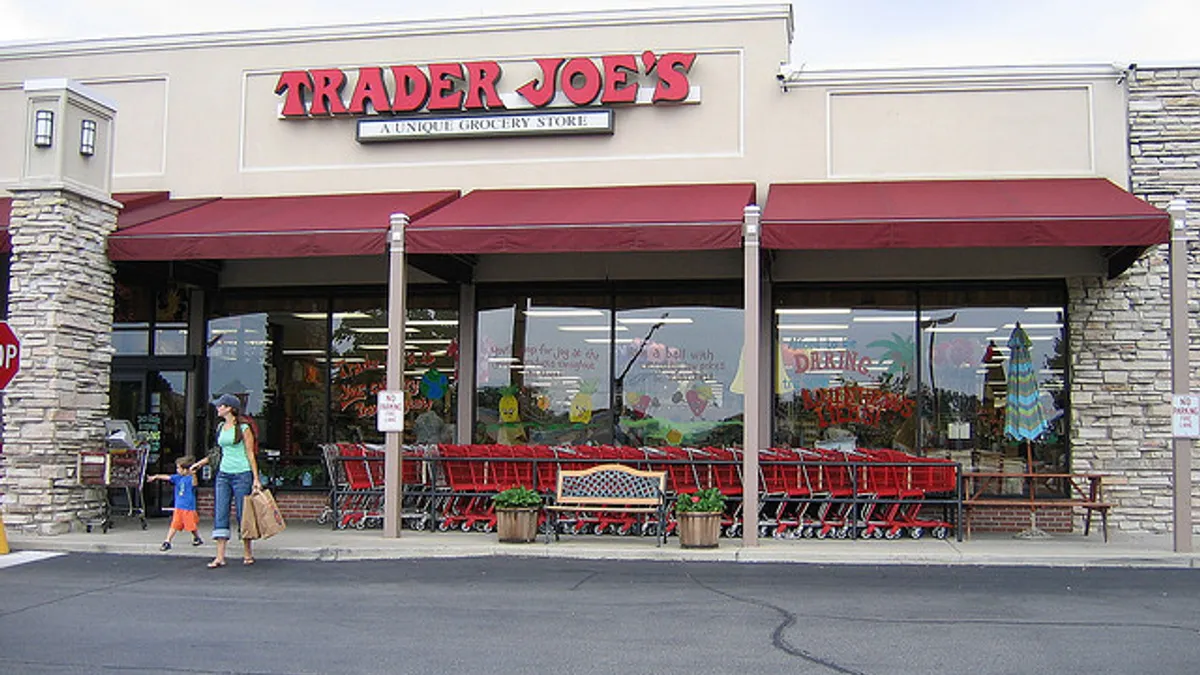Dive Brief:
- Trader Joe’s will discontinue grocery delivery in New York City on March 1, Business Insider first reported. Although grocery delivery is not an option for most Trader Joe’s shoppers, the service has been available to customers in New York for about 10 years. The grocer does not have plans to bring grocery delivery to any other markets.
- A Trader Joe’s spokesperson confirmed the move to Business Insider, saying that grocery delivery had become too costly. “Instead of passing along unsustainable cost increases to our customers, removing delivery will allow us to continue offering outstanding values — quality products for great everyday prices, and to make better use of valuable space in our stores,” she noted.
- The move comes at a time when companies such as Walmart, Kroger and Amazon are expanding their delivery options. An article in Bloomberg suggests that Trader Joe’s decision reflects the fierce competition for grocery delivery in New York City, and that grocery e-commerce providers in the area will vie for Trader Joe’s share of the delivery market.
Dive Insight:
Grocery delivery has been available to Trader Joe’s customers in certain areas of New York City for the last decade. The service was not tied to e-commerce, and this shopper’s account of the experience from 2012 explains that customers could shop for their groceries in the store and select a delivery window later in the day. Trader Joe’s has made it clear that it does not offer e-commerce, nor does it plan to, because the brick-and-mortar store is the heart of its brand.
It appears that the cost of offering grocery delivery to customers now outweighs the benefit, especially because the delivery option still requires Trader Joe’s shoppers to come in-store to make their purchases. What was once a special offering for urbanites that drove customer loyalty in the era before e-commerce may now be driving pressure on the grocer to set up shop online – a risky move given the intense competition in New York from Jet.com, Instacart, FreshDirect and Amazon. Ultimately, there is no real motivation for Trader Joe’s to deliver groceries anymore beyond it being a nice-to-have service for some urban shoppers.
While the general move toward e-commerce in the industry would suggest that Trader Joe’s establish an online presence, survey after survey finds that Trader Joe’s remains a fan favorite for its in-store experience, memorable private label products and low prices. The company has been successful everywhere it goes, and customer demand for expansion is still strong. While most grocers have to jump on e-commerce to survive, Trader Joe’s may be the exception.
There are several costs associated with grocery delivery – from labor costs to refrigerated trucks to packaging costs. Often grocers pass some of these costs on in the form of delivery fees, but fees typically fail to offset costs completely. In today’s competitive grocery landscape, every dollar counts, and for a company like Trader Joe’s that delivers value to shoppers who are willing to spend their time in a store they love, cutting operating costs in any manner is a smart move.
It’s also important to note that third-party grocery delivery services such as Postmates do deliver groceries from Trader Joe’s in select markets nationwide, and the retailer also sells some of its products on Amazon. (Trader Joe’s also piloted grocery delivery using Instacart in 2013, but the relationship was short-lived.) So while the company isn’t engaging directly in e-commerce, loyal fans can still find ways to get groceries delivered from Trader Joe’s, and it is possible that the retailer sees value in letting third-party providers satisfy that need while it continues to strengthen its brick-and-mortar brand.













